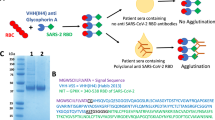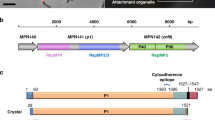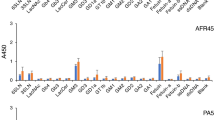Abstract
Two distinct, specific, “soluble” precipitinogens—θ and ι—have been detected by immunodiffusion in concentrates of medium from pig kidney cell cultures (PS-RV) chronically infected with rubella virus. Antibody reactants have included convalescent phase sera from rubella patients and sera of hyperimmunized baboons. I have already described1 the preparation and assay of antigen concentrates and I now describe some of the physicochemical properties of the two antigens.
This is a preview of subscription content, access via your institution
Access options
Subscribe to this journal
Receive 51 print issues and online access
$199.00 per year
only $3.90 per issue
Buy this article
- Purchase on Springer Link
- Instant access to full article PDF
Prices may be subject to local taxes which are calculated during checkout
Similar content being viewed by others
References
Le Bouvier, G. L., Proc. Soc. Exp. Biol. and Med. (in the press).
Liebhaber, H., Riordan, J. T., and Horstmann, D. M., Proc. Soc. Exp. Biol. and Med., 125, 636 (1967).
Svehag, S. E., and Mandel, B., J. Exp. Med., 119, 1 (1964).
Schmidt, N. J., and Styk, B., J. Immunol., 101, 210 (1968).
Le Bouvier, G. L., Sussman, M., and Crawford, L. V., J. Gen. Microbiol., 45, 497 (1966).
Liebhaber, H., and Pajot, T., Proc. Soc. Exp. Biol. and Med. (in the press).
Author information
Authors and Affiliations
Rights and permissions
About this article
Cite this article
LE BOUVIER, G. Physicochemical Characteristics of Rubella Antigens Theta and Iota. Nature 221, 78–79 (1969). https://doi.org/10.1038/221078a0
Received:
Issue Date:
DOI: https://doi.org/10.1038/221078a0
This article is cited by
-
Preparation of rubella virus antigens for immunodiffusion by mild extraction of infected cells with a neutral detergent
Archiv f�r die gesamte Virusforschung (1973)
-
Small size rubella virus antigens and soluble immune complexes: Analysis by the platelet aggregation technique
Archiv f�r die gesamte Virusforschung (1971)
-
Characteristics of gel precipitating antigens of rubella virus
Archiv f�r die gesamte Virusforschung (1970)
Comments
By submitting a comment you agree to abide by our Terms and Community Guidelines. If you find something abusive or that does not comply with our terms or guidelines please flag it as inappropriate.



